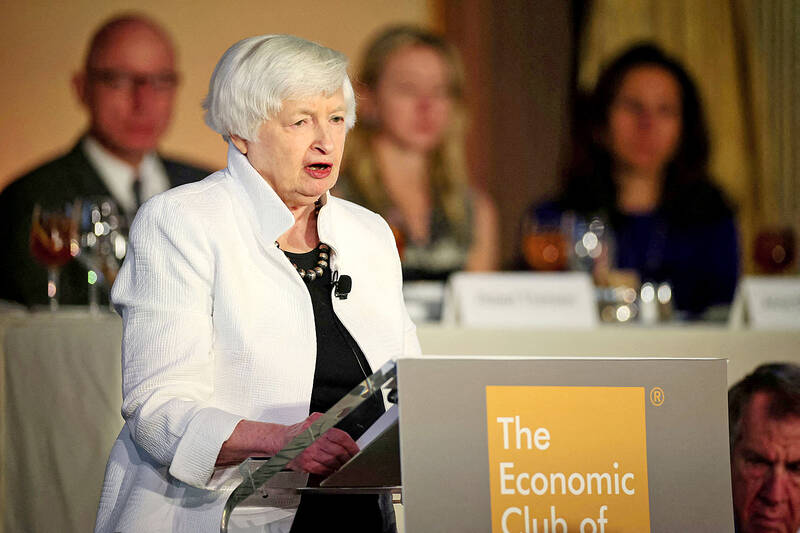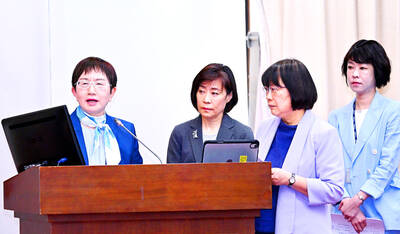The US Department of the Treasury on Thursday said no major trading partner appeared to have manipulated its currency last year, but it added Japan to a foreign exchange “monitoring list,” alongside China, Vietnam, Taiwan, Malaysia, Singapore and Germany, which were on the previous list.
The Treasury’s semi-annual currency report found that none of the countries examined met all three criteria triggering “enhanced analysis” of their foreign exchange practices during the four quarters through December last year.
Countries are automatically added to the list if they meet two of the three criteria: a trade surplus with the US of at least US$15 billion, a global account surplus above 3 percent of GDP and persistent one-way net foreign exchange purchases of at least 2 percent of GDP over 12 months.

Photo: Reuters
Japan, Taiwan, Vietnam and Germany all met the criteria for trade surpluses and an outsized current account surplus, the Treasury said.
Singapore met the criteria for engaging in persistent foreign exchange intervention and a material current account surplus; Malaysia only met the current account surplus criteria, but once on the list, it takes two currency report cycles to be dropped off.
China was kept on the monitoring list because of its large trade surplus with the US and because of a lack of transparency surrounding its foreign exchange policies.
“China’s failure to publish foreign exchange intervention and broader lack of transparency around key features of its exchange rate mechanism continues to make it an outlier among major economies and warrants Treasury’s close monitoring,” the Treasury said in the report.
The report also raises questions about China’s reporting of data on its current account balance, which showed its surplus fell to 1.4 percent of GDP last year from 2.5 percent in 2022.
The Treasury said China’s balance of payments data published by the State Administration of Foreign Exchange on the nation’s trade surplus appear to be at odds with China’s own customs data and that of other trading partners.
A US Treasury official said the department was trying to understand such “anomalies.”
The official said Japan’s recent foreign exchange interventions to prop up the yen were not a factor in deciding to add the country to the currency monitoring list.
The official cited Japan’s high trade surplus of US$62.4 billion with the US and its global current account surplus of 3.5 percent of GDP last year, up from 1.8 percent in 2022.
However, the Treasury report said that Japan had intervened in April and last year — outside the period covered by the report — for the first time since October 2022, buying yen and selling US dollars to boost the yen’s value.
The Treasury said Japan was transparent in its foreign exchange operations, but added: “Treasury’s expectation is that in large, freely traded exchange markets, intervention should be reserved only for very exceptional circumstances with appropriate prior consultations.”
Speaking to reporters on Thursday, Japan’s top currency diplomat, Vice Minister for International Affairs Masato Kanda, said he did not see a problem with Japan being included on the US currency monitoring list, adding that it was assessed according to mechanical criteria.
The report said most foreign exchange interventions last year focused on selling US dollars — actions that strengthen a currency’s value against the greenback.
The US dollar has strengthened over the past two years as the US Federal Reserve has raised interest rates sharply to cool inflation.
The greater concern in the Treasury report is on interventions to buy US dollars and thus weaken other currencies.

‘SWASTICAR’: Tesla CEO Elon Musk’s close association with Donald Trump has prompted opponents to brand him a ‘Nazi’ and resulted in a dramatic drop in sales Demonstrators descended on Tesla Inc dealerships across the US, and in Europe and Canada on Saturday to protest company chief Elon Musk, who has amassed extraordinary power as a top adviser to US President Donald Trump. Waving signs with messages such as “Musk is stealing our money” and “Reclaim our country,” the protests largely took place peacefully following fiery episodes of vandalism on Tesla vehicles, dealerships and other facilities in recent weeks that US officials have denounced as terrorism. Hundreds rallied on Saturday outside the Tesla dealership in Manhattan. Some blasted Musk, the world’s richest man, while others demanded the shuttering of his

ADVERSARIES: The new list includes 11 entities in China and one in Taiwan, which is a local branch of Chinese cloud computing firm Inspur Group The US added dozens of entities to a trade blacklist on Tuesday, the US Department of Commerce said, in part to disrupt Beijing’s artificial intelligence (AI) and advanced computing capabilities. The action affects 80 entities from countries including China, the United Arab Emirates and Iran, with the commerce department citing their “activities contrary to US national security and foreign policy.” Those added to the “entity list” are restricted from obtaining US items and technologies without government authorization. “We will not allow adversaries to exploit American technology to bolster their own militaries and threaten American lives,” US Secretary of Commerce Howard Lutnick said. The entities

Minister of Finance Chuang Tsui-yun (莊翠雲) yesterday told lawmakers that she “would not speculate,” but a “response plan” has been prepared in case Taiwan is targeted by US President Donald Trump’s reciprocal tariffs, which are to be announced on Wednesday next week. The Trump administration, including US Secretary of the Treasury Scott Bessent, has said that much of the proposed reciprocal tariffs would focus on the 15 countries that have the highest trade surpluses with the US. Bessent has referred to those countries as the “dirty 15,” but has not named them. Last year, Taiwan’s US$73.9 billion trade surplus with the US

Prices of gasoline and diesel products at domestic gas stations are to fall NT$0.2 and NT$0.1 per liter respectively this week, even though international crude oil prices rose last week, CPC Corp, Taiwan (台灣中油) and Formosa Petrochemical Corp (台塑石化) said yesterday. International crude oil prices continued rising last week, as the US Energy Information Administration reported a larger-than-expected drop in US commercial crude oil inventories, CPC said in a statement. Based on the company’s floating oil price formula, the cost of crude oil rose 2.38 percent last week from a week earlier, it said. News that US President Donald Trump plans a “secondary